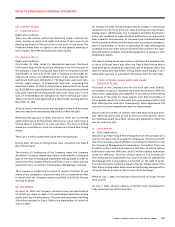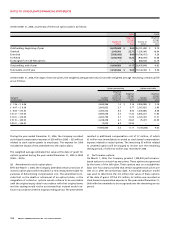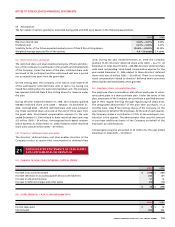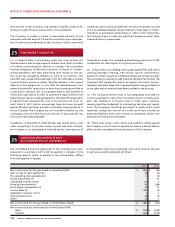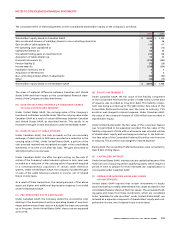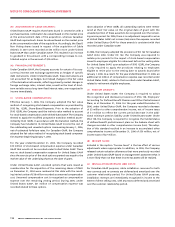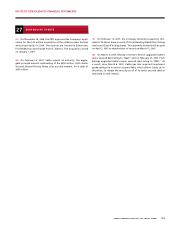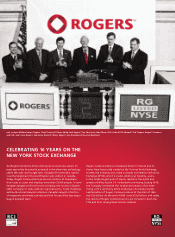Rogers 2006 Annual Report Download - page 116
Download and view the complete annual report
Please find page 116 of the 2006 Rogers annual report below. You can navigate through the pages in the report by either clicking on the pages listed below, or by using the keyword search tool below to find specific information within the annual report.
112 RO GER S COMM UNIC AT ION S IN C . 20 0 6 ANN UA L RE PORT
NOTES TO CONSOLIDATED FINANCIAL STATEMENTS
2006 2005
Current service cost (employer portion) $ 24 $ 15
Interest cost 32 29
Expected return on plan assets (33) (30)
Amortization:
Transitional asset (10) (10)
Realized gains included in income 1 1
Net actuarial loss 10 8
Net periodic pension cost $ 24 $ 13
Accrued benefit asset $ 34 $ 13
Accumulated other comprehensive income (loss) (97) 19
Net amount recognized in balance sheet $ (63) $ 32
In addition to the amounts disclosed above, under United States
GAAP, the accrued benefit liability related to the Company’s sup-
plemental unfunded pension benefits for certain executives was
$19 million (2005 – $16 million).
(R) RECENT UNITED STATES ACCOUNTING PRONOUNCEMENTS:
In December 2006, the Company adopted Staff Accounting Bulletin
No. 108, Considering the Effects of Prior Year Misstatements when
Quantifying Misstatements in Current Year Financial Statements
(“SAB 108”). SAB 108 clarifies the way that a company should eval-
uate identified unadjusted errors for materiality. The Company
elected, as allowed under SAB 108, to reflect the effect of initially
applying the guidance by adjusting the carrying amount of respec-
tive accounts at the beginning of 2006 and recording an offsetting
adjustment to the opening balance of deficit in 2006. Accordingly,
the Company recorded a cumulative adjustment to decrease deficit
by $28 million related to the accounting for financial instruments
under United States GAAP.
In November 2004, the FASB issued SFAS No. 151, Inventory Costs, an
amendment of ARB No. 43, Chapter 4 (“SFAS 151”). This statement
amends the guidance in ARB No. 43, Chapter 4, Inventory Pricing, to
clarify the accounting for abnormal amounts of idle facility expense,
freight, handling costs, and wasted material (spoilage). SFAS 151
requires that those items be recognized as current-period charges. In
addition, this statement requires that allocation of fixed production
overheads to costs of conversion be based upon the normal capacity
of the production facilities. The provisions of SFAS 151 were effective
for the Company on January 1, 2006. This revised standard did not
have a material impact on the results of the Company under United
States GAAP.
SFAS No. 153, Exchanges Of Non-Monetary Assets – an Amendment of
APB Opinion 29 (“SFAS 153”), was issued in December 2004. APB Opin ion
29 is based on the principle that exchanges of non-monetary assets
should be measured based on the fair value of assets exchanged.
SFAS 153 amends APB Opinion 29 to eliminate the exception for non-
monetary exchanges of similar productive assets and replaces it with
a general exception for exchanges of non-monetary assets that do
not have commercial substance. The standard was effective for the
Company for non-monetary asset exchanges occurring in fiscal 2006
and was applied prospectively. The revised standard did not have a
material impact on the results of the Company under United States
GAAP.
In June 2005, the FASB issued SFAS No. 154, Accounting Changes and
Error Corrections, a replacement of APB Opinion No. 20, Accounting
Changes (“Opinion 20”), and FASB Statement No. 3, Reporting
Accounting Changes in Interim Financial Statements (“SFAS 154”).
The Statement applies to all voluntary changes in accounting princi-
ple, and changes the requirements for accounting for and reporting
of a change in accounting principle. SFAS 154 requires retrospective
application to prior periods’ financial statements of a voluntary
change in accounting principle unless it is impracticable. SFAS 154
requires that a change in method of depreciation, amortization,
or depletion for long-lived, non-financial assets be accounted for
as a change in accounting estimate that is affected by a change in
accounting principle. Opinion 20 previously required that such a
change be reported as a change in accounting principle. SFAS 154
was effective for accounting changes and corrections of errors made
in fiscal years beginning after December 15, 2005. This standard did
not have a material impact on the results of the Company under
United States GAAP.
In June 2006, the FASB issued Interpretation No. 48, Accounting for
Uncertainty in Income Taxes, an Interpretation of SFAS 109. This
interpretation prescribes the measurement and recognition criteria
of a tax position taken or expected to be taken in a tax return. This
interpretation is effective for the Company beginning January 1,
2007. The Company is currently assessing the impact of this standard.
In September 2006, the FASB issued SFAS 157, Fair Value Measurements.
This new standard defines fair value, establishes a framework for
measuring fair value under generally accepted accounting principles
and expands disclosures about fair value measurements. This new
standard is effective for the Company beginning January 1, 2008.
The Company is currently assessing the impact of this standard.



